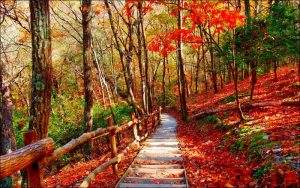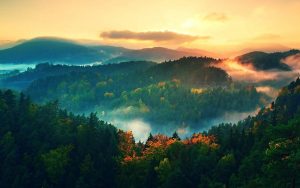The United States of America is rich in history, culture, and diversity. From its bustling cities to its stunning natural landscapes, there’s always something new to discover. Here are 25 fun facts about the USA that you might not have known
Alaska’s Coastline
Alaska’s coastline stretches over 6,600 miles, surpassing the combined coastlines of all other U.S. states. This vast expanse includes rugged cliffs, pristine beaches, and picturesque fjords, making it one of the most scenic coastlines in the world. Alaska’s coastline is home to diverse wildlife, including whales, seals, and seabirds, and offers plenty of opportunities for outdoor adventures such as kayaking, fishing, and wildlife viewing. The coastline’s remote and untouched beauty attracts visitors from around the globe, seeking to experience the majesty of Alaska’s natural landscapes.
The Liberty Bell
The Liberty Bell, an iconic symbol of American independence, is known for its crack, which occurred not during the Revolutionary War as many believe, but during a test ringing in 1846. The crack rendered the bell unringable, but it continued to serve as a powerful symbol of freedom and democracy. Despite its crack, the Liberty Bell has become a cherished artifact, and its image is widely recognized as a symbol of American ideals of liberty and justice.
National Parks
The United States boasts 63 national parks, showcasing the country’s diverse landscapes and natural beauty. California and Alaska are home to the most national parks, each offering stunning scenery and unique wildlife. These parks are protected areas that preserve the natural environment and provide opportunities for outdoor recreation, education, and conservation. From the towering redwoods of California to the rugged mountains of Alaska, each national park offers a unique and unforgettable experience for visitors to explore and enjoy.
These all are national parks in USA
- Yellowstone National Park – Wyoming, Montana, Idaho
- Yosemite National Park – California
- Grand Canyon National Park – Arizona
- Glacier National Park – Montana
- Great Smoky Mountains National Park – North Carolina, Tennessee
- Rocky Mountain National Park – Colorado
- Zion National Park – Utah
- Olympic National Park – Washington
- Grand Teton National Park – Wyoming
- Acadia National Park – Maine
- Joshua Tree National Park – California
- Bryce Canyon National Park – Utah
- Death Valley National Park – California, Nevada
- Shenandoah National Park – Virginia
- Everglades National Park – Florida
- Arches National Park – Utah
- Sequoia National Park – California
- Capitol Reef National Park – Utah
- Petrified Forest National Park – Arizona
- Saguaro National Park – Arizona
- Badlands National Park – South Dakota
- Mount Rainier National Park – Washington
- Great Sand Dunes National Park – Colorado
- Canyonlands National Park – Utah
- Black Canyon of the Gunnison National Park – Colorado
- Cuyahoga Valley National Park – Ohio
- Carlsbad Caverns National Park – New Mexico
- Redwood National and State Parks – California
- Mammoth Cave National Park – Kentucky
- Big Bend National Park – Texas
- Mesa Verde National Park – Colorado
- Kings Canyon National Park – California
- Pinnacles National Park – California
- Lassen Volcanic National Park – California
- Isle Royale National Park – Michigan
- Channel Islands National Park – California
- Voyageurs National Park – Minnesota
- Guadalupe Mountains National Park – Texas
- Hot Springs National Park – Arkansas
- Wind Cave National Park – South Dakota
- Wrangell-St. Elias National Park – Alaska
- Great Basin National Park – Nevada
- Theodore Roosevelt National Park – North Dakota
- Haleakalā National Park – Hawaii
- Kenai Fjords National Park – Alaska
- Katmai National Park – Alaska
- North Cascades National Park – Washington
- Dry Tortugas National Park – Florida
- Biscayne National Park – Florida
- Congaree National Park – South Carolina
- Pictured Rocks National Lakeshore – Michigan
- Indiana Dunes National Park – Indiana
- Gateway Arch National Park – Missouri
- White Sands National Park – New Mexico
- Great Basin National Park – Nevada
- Black Canyon of the Gunnison National Park – Colorado
- Saguaro National Park – Arizona
- Canyonlands National Park – Utah
- Everglades National Park – Florida
- Virgin Islands National Park – U.S. Virgin Islands
- Hawai’i Volcanoes National Park – Hawaii
- Redwood National Park – California
- Denali National Park – Alaska
Tallest Mountain
Mauna Kea, located in Hawaii, is the tallest mountain on Earth when measured from base to summit. While Mount Everest is the highest mountain above sea level, Mauna Kea’s base is at the bottom of the Pacific Ocean, giving it a total height of about 33,500 feet—significantly taller than Everest’s 29,029-foot height. Mauna Kea is a dormant volcano, and its summit is often covered in snow, offering a striking contrast to the tropical beaches below. The mountain is considered sacred in Hawaiian culture and is home to important cultural and archaeological sites.
State Names
Maine is the only state in the United States with a single-syllable name. The name “Maine” is thought to have originated from the ancient French province of Maine. Maine is known for its stunning coastline, picturesque lighthouses, and vibrant fall foliage. The state is also famous for its lobster industry, producing some of the finest lobster in the country. With its rich history, beautiful landscapes, and unique culture, Maine is a fascinating destination for visitors seeking to explore the beauty of New England.
Barbie’s Full Name
Barbie’s full name is Barbara Millicent Roberts. She was created by Ruth Handler and debuted at the American International Toy Fair in New York on March 9, 1959. Barbie has since become a cultural icon, representing fashion, beauty, and a range of careers and lifestyles through her various dolls and accessories. Over the years, Barbie has evolved to reflect changing trends and societal expectations, making her one of the most recognizable and enduring toys in history.
Denali
Denali, located in Alaska, is the highest peak in North America, with an elevation of 20,310 feet (6,190 meters) above sea level. Formerly known as Mount McKinley, it was renamed Denali in 2015 to honor its Native American name, which means “the high one” or “the great one” in the Athabaskan language. Denali is part of the Alaska Range and is known for its extreme weather conditions and challenging climbing routes, attracting mountaineers from around the world. The mountain and its surrounding wilderness are protected within Denali National Park and Preserve, offering visitors a chance to experience the beauty and solitude of this iconic peak.
Time Zones
The United States spans six time zones from the East Coast to the Aleutian Islands in Alaska. The time zones are Eastern Standard Time (EST), Central Standard Time (CST), Mountain Standard Time (MST), Pacific Standard Time (PST), Alaska Standard Time (AKST), and Hawaii-Aleutian Standard Time (HST). This vast geographical expanse results in a wide range of daylight hours and time differences across the country. The time zones are standardized by the Coordinated Universal Time (UTC) offset, which is adjusted for daylight saving time in most states, except for Arizona (with the exception of the Navajo Nation) and Hawaii.
Famous Inventors
The Missouri River is the longest river in the United States, stretching approximately 2,341 miles (3,767 kilometers) from its source in the Rocky Mountains of western Montana to its confluence with the Mississippi River near St. Louis, Missouri. The river passes through seven states: Montana, North Dakota, South Dakota, Nebraska, Iowa, Kansas, and Missouri. The Missouri River played a crucial role in the westward expansion of the United States, serving as a major transportation route for explorers, fur traders, and settlers in the 19th century. Today, the Missouri River remains an important waterway for commerce, recreation, and wildlife habitat.
No Official Language
The United States does not have an official language at the federal level. While English is the most widely spoken language and is used for government operations, there is no official designation. This lack of an official language reflects the cultural and linguistic diversity of the country, with many languages spoken by different communities throughout the nation. The absence of an official language underscores the principles of freedom of speech and expression enshrined in the First Amendment of the U.S. Constitution, allowing individuals to communicate in the language of their choice.
First Capital
The first capital of the United States was not Washington D.C., but New York City. In 1789, when George Washington was inaugurated as the first President of the United States, New York City served as the nation’s capital. The city remained the capital until 1790 when the capital was moved to Philadelphia, Pennsylvania. It was not until 1800 that the capital was permanently moved to Washington D.C., where it remains today. The choice of Washington D.C. as the capital was part of a compromise between the northern and southern states, as it was located between the North and the South.
State Borders
There is a point in Arizona where you can stand in four states at once: Arizona, New Mexico, Utah, and Colorado. Known as the Four Corners Monument, it marks the only point in the United States where the boundaries of four states meet. The monument consists of a granite disk embedded with the state seals and surrounded by flags representing each state. Visitors can stand on the disk and have a limb in each of the four states, making it a popular tourist destination and a unique geographical curiosity.
Statue of Liberty
The Statue of Liberty was a gift from France to the United States in 1886. Designed by French sculptor Frédéric Auguste Bartholdi, the statue was dedicated on October 28, 1886, and has since become a symbol of freedom and democracy. The statue, which stands on Liberty Island in New York Harbor, depicts a robed female figure representing Libertas, the Roman goddess of freedom, holding a torch and a tablet inscribed with the date of the American Declaration of Independence. The Statue of Liberty is one of the most iconic landmarks in the United States and is visited by millions of people from around the world each year.
Oldest City
St. Augustine, Florida, is the oldest continuously inhabited European-established settlement in the continental United States. Founded by Spanish explorers in 1565, St. Augustine predates the founding of Jamestown, Virginia, by over 40 years and the landing of the Mayflower at Plymouth Rock by over 50 years. The city has a rich history, with many of its original buildings and structures still standing, including the Castillo de San Marcos, a 17th-century fortress. Today, St. Augustine is a popular tourist destination known for its historic architecture, museums, and beautiful beaches.
Largest Library
The Library of Congress is the largest library in the world, with over 170 million items in its collections. Located in Washington D.C., the library serves as the research library for the U.S. Congress and is open to the public for research purposes. The Library of Congress was established in 1800, making it the oldest federal cultural institution in the United States. Its collections include books, manuscripts, maps, photographs, and recordings, covering a wide range of subjects and formats. The library’s mission is to provide access to knowledge and creativity for the benefit of the American people.
National Bird
The bald eagle is not only the national bird but also the national animal of the United States. This majestic bird of prey has been a symbol of American strength and freedom since the country’s founding. The bald eagle’s striking appearance, with its white head and tail contrasting against a dark brown body, has made it a popular emblem on flags, seals, and coins. Despite being on the brink of extinction in the 20th century due to habitat destruction and hunting, conservation efforts have helped the bald eagle population recover, and it was removed from the endangered species list in 2007. Today, the bald eagle is a proud symbol of America’s natural beauty and resilience.
Hollywood
The United States is home to Hollywood, the oldest film industry in the world. Located in Los Angeles, California, Hollywood has been a major center for movie production since the early 20th century. The area is known for its iconic Hollywood sign, Walk of Fame, and numerous movie studios and production companies. Hollywood has been the birthplace of countless iconic films, actors, and directors, shaping the global film industry and popular culture. Today, Hollywood continues to be a hub of creativity and innovation, producing some of the world’s most beloved and influential films.
Longest River
The Grand Canyon is one of the most spectacular natural wonders of the world. Carved by the Colorado River over millions of years, this massive canyon stretches for 277 miles (446 kilometers) and reaches depths of over a mile (1.6 kilometers). The Grand Canyon is known for its breathtaking beauty and vibrant colors, with layers of rock that reveal millions of years of Earth’s geological history. Visitors from around the world come to marvel at the Grand Canyon’s awe-inspiring vistas, hike its rugged trails, and experience the wonder of this iconic natural landmark.
First President
The Golden Gate Bridge in San Francisco, California, is one of the most iconic bridges in the world. Completed in 1937, this suspension bridge spans the Golden Gate Strait, the entrance to San Francisco Bay from the Pacific Ocean. The bridge’s Art Deco design and distinctive “International Orange” color make it a striking landmark against the backdrop of the bay and the city skyline. The Golden Gate Bridge is not only a vital transportation link for the city but also a symbol of San Francisco and a popular tourist attraction, drawing millions of visitors each year to walk, bike, or drive across its span.
Largest Pizza
The Great Lakes, consisting of Lakes Superior, Michigan, Huron, Erie, and Ontario, are the largest group of freshwater lakes in the world by total area. They are located in northeastern North America, straddling the border between the United States and Canada. The Great Lakes are of immense ecological importance, containing about 84% of North America’s surface freshwater and serving as a vital habitat for a wide range of plant and animal species. The lakes also play a crucial role in transportation, recreation, and the economies of the surrounding region.
Moon Landings
Mount Rushmore, located in the Black Hills of South Dakota, is a monumental sculpture carved into the granite face of the mountain. The sculpture features the heads of four U.S. presidents: George Washington, Thomas Jefferson, Theodore Roosevelt, and Abraham Lincoln, each representing different aspects of American history and values. Mount Rushmore is a symbol of American democracy and is visited by millions of people from around the world each year. The monument is not only a testament to the skill and artistry of its creators but also a powerful reminder of the ideals and principles upon which the United States was founded.
Mount Rushmore
The Appalachian Trail is a 2,200-mile (3,500-kilometer) long hiking trail that stretches from Georgia to Maine, making it one of the longest continuous footpaths in the world. The trail passes through 14 states and traverses diverse landscapes, including mountains, forests, and meadows. Established in 1937, the Appalachian Trail offers hikers a unique opportunity to experience the natural beauty and cultural heritage of the eastern United States. It is a popular destination for thru-hikers, who attempt to hike the entire trail in one season, as well as for day hikers and backpackers looking to explore shorter sections of the trail.
First Capital Punishment Law
Yellowstone National Park, located primarily in the U.S. state of Wyoming, was established in 1872 as the first national park in the world. The park is known for its stunning natural beauty, including dramatic canyons, alpine rivers, lush forests, and abundant wildlife. Yellowstone is also home to over half of the world’s geothermal features, including geysers, hot springs, and mud pots, the most famous of which is Old Faithful. The park’s diverse ecosystems and geothermal wonders make it a unique and iconic destination, attracting millions of visitors from around the world each year.
Biggest Stadium
The Hoover Dam, located on the border between the U.S. states of Nevada and Arizona, is a marvel of modern engineering. Built during the Great Depression, the dam was completed in 1936 and stands as a testament to American ingenuity and perseverance. The dam was constructed to harness the power of the Colorado River, providing water and hydroelectric power to the surrounding region. Hoover Dam is a popular tourist attraction, drawing visitors who marvel at its sheer size and impressive architecture. The dam’s construction also created Lake Mead, the largest reservoir in the United States, which offers recreational opportunities such as boating, fishing, and swimming.
Most Visited Museum
The White House, located in Washington D.C., is the official residence and workplace of the President of the United States. It was designed by James Hoban and has been the residence of every U.S. president since John Adams in 1800. The White House is a symbol of American democracy and is recognized worldwide as a symbol of the presidency and the United States government. The building is also a popular tourist attraction, with thousands of visitors touring its public rooms each year.




